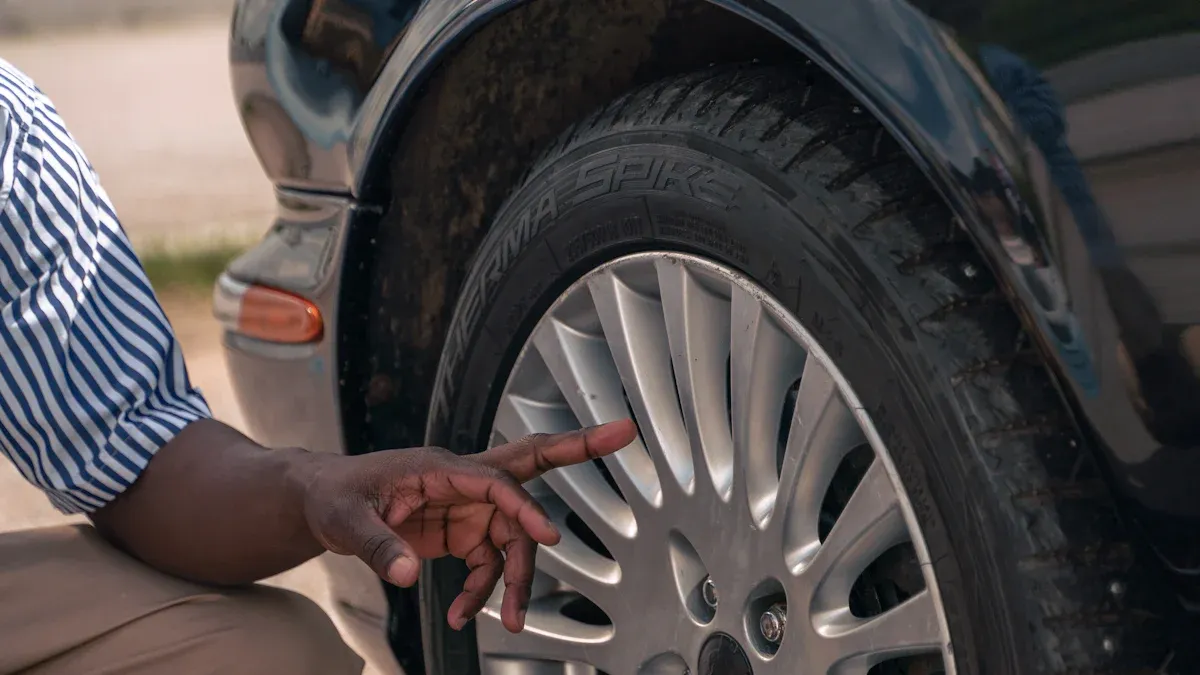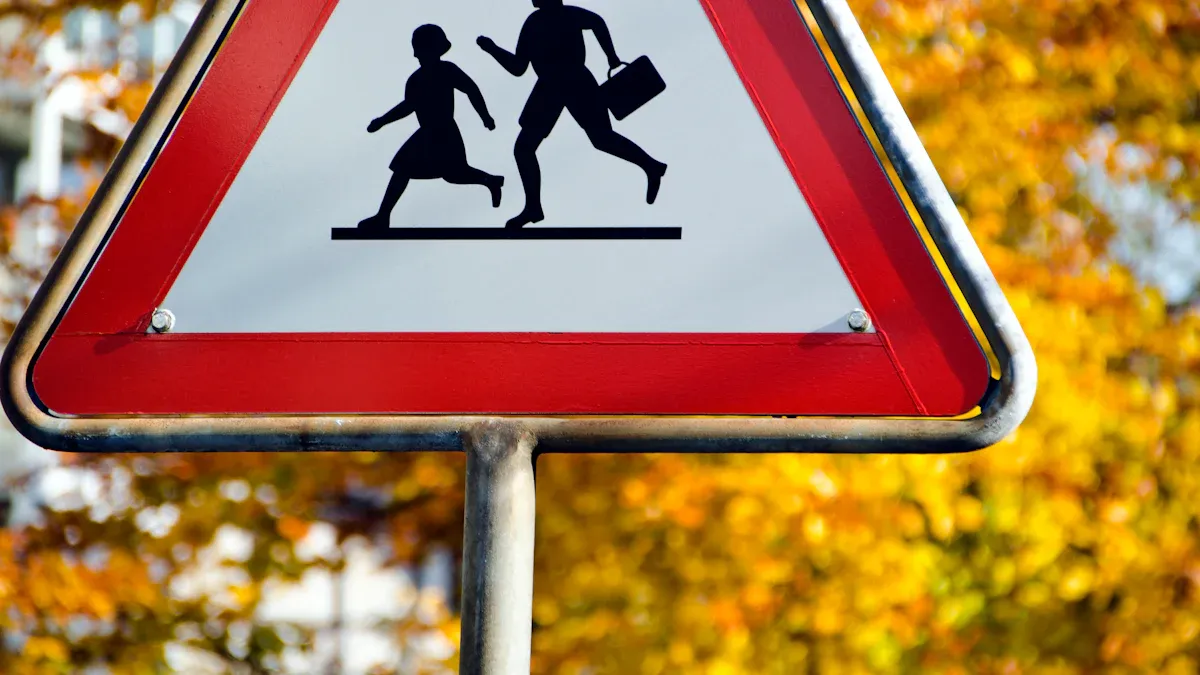
Tire wear is very important for your safety. Worn tires can make it harder to stop. They also reduce grip on the road. Have you looked at your tire tread recently? Do you know how tire pressure changes your driving? The National Motor Vehicle Crash Causation Survey says that about 9% of accidents happen because of tire problems. This shows why you need to take care of your tires. Knowing how tire wear affects your vehicle can help you drive safely.
Puncte cheie
Worn tires make it harder to stop. They also reduce grip. This makes driving unsafe, especially when it’s wet.
Check your tire pressure every month. Keep it at the right level. This helps prevent uneven wear and saves fuel.
Look at your adâncimea profilului anvelopei often. Use simple tools or tests. This helps you know when to replace tires and avoid accidents.
Keep your wheels aligned. Rotate your tires every 5,000 to 7,500 miles. This helps ensure even wear and makes tires last longer.
Drive smoothly. Avoid hard braking and fast turns. Don’t overload your vehicle. This helps reduce tire wear and keeps you safe.
Tire Wear Basics
Knowing about tire wear is very important for your safety. Tire wear means the slow wearing down of the tire tread. This can really change how your vehicle works. There are different types of tire wear. Each type shows different problems that you might need to fix.
Types of Tire Wear
Here are some common types of tire wear you might see:
Tire Wear Type | Description & Cause | Implications & Recommendations |
|---|---|---|
Inner or Outer Shoulder Wear | This happens when the edges of tires wear out faster. It is often due to wheel alignment problems. | This can make your vehicle pull to one side; get a wheel alignment. |
Uzura centrală | This is when the middle of the tire tread wears down too much. It usually happens from overinflation. | This leads to less grip and faster wear; check your tire pressure. |
Edge Shoulder Wear | This is when both edges of the tire wear out. It is caused by underinflation and uneven weight. | This lowers fuel efficiency and raises blowout risk; inflate tires correctly. |
Cupping/Scalloping Wear | This shows a diagonal pattern and means your suspension parts may be weak. | This causes a bumpy ride and noise; check your suspension. |
Patchy, Diagonal Wear | This is uneven wear that often happens from tire imbalance and not rotating tires. | This can cause heat buildup and less grip; rotate and balance tires often. |
You can spot tire wear by looking for signs like feathering. This is when the tread edges feel fuzzy. You might also see center wear, where the middle tread is more worn than the edges. Checking your tires regularly helps you find these problems early.
Cauzele uzurii anvelopelor
Many things can cause tire wear. Here are some common reasons:
Improper Tire Pressure: Both too little and too much air can cause uneven wear. Under-inflated tires wear on the edges. Over-inflated tires wear in the middle.
Misalignment: If your wheels are not lined up right, it can cause uneven wear. This may lead to needing new tires sooner.
Driving Habits: Driving too fast or braking hard can speed up tire wear. Also, making sharp turns often can cause uneven tread wear.
Load Distribution: Carrying too much weight or uneven weight can make tires wear out faster. Always make sure your load is balanced and not too heavy.
By knowing these types and causes of tire wear, you can take steps to keep your tires in good shape. This helps you drive safely.
Tire Wear and Driving Safety

Tire wear affects how safe you are when driving. It changes how quickly you can stop and how well your tires grip the road. Knowing this can help you take care of your tires better.
Braking Distance Implications
Worn tires can make it take longer to stop, especially when it’s wet. Studies show that new tires can stop in about 160 feet. But tires worn down to the legal limit of 2/32 inches may need up to 250 feet to stop. That is a huge 64% reduction in braking efficiency. Tires below the legal limit can take up to 300 feet to stop. This shows how important tread depth is for stopping.
Key Points:
Tires with a tread depth of 4/32 inches increase braking distance by 43% in wet conditions.
This means about 87 feet longer stopping distance at highway speeds.
Worn tires may still be going 40 mph when new tires have already stopped.
The table below shows how tread depth affects stopping distance in emergencies:
Adâncimea benzii de rulare (mm) | Stopping Distance (m) | Increase Compared to New Tires |
|---|---|---|
8 (new tires) | 60 | Baseline |
3 (worn tires) | 90 | 50% increase |
1.5 (bald tires) | 115 | Significant increase |
As you can see, less tread means a longer stopping distance. This can be the difference between stopping safely and crashing.
Traction and Stability
Tire wear also changes traction and stability, which are very important for safe driving. When tires wear unevenly, they do not grip the road well. This can create dangerous situations, especially when turning or making quick moves.
Consider these factors:
Worn tires lower tire-road friction, making stopping harder.
Good tread depth helps move water away from the tire, lowering hydroplaning risk.
Keeping a tread depth above 2/32 inci is key for safe driving, especially in wet weather.
To check your tire tread depth, you can use a handheld tire tread depth tool. This tool gives you accurate readings of your tire wear. Key features of these tools include:
Precision Measurement: They give exact tread depth readings, so you know when to change your tires.
Easy to Use: Most tools are simple and do not need expert help.
Safety Enhancement: Regular checks help keep your tread depth good, improving your stopping distance and grip.
By watching your tire wear and using tools to measure it, you can drive safer and lower the chance of accidents.
Importance of Tire Maintenance

Taking care of your tires is very important for safe driving. Checking them regularly can help you find problems before they get worse. You should look at your tire pressure and tread depth often to make sure your tires work well.
Regular Checks
Experts say you should check your tire pressure at least once a month. It’s best to do this when the tires are cold for the most accurate results. Keeping the right air in your tires helps keep you safe, makes your vehicle work better, and helps your tires last longer. Here are some important points to remember:
Tire Pressure: Use a good tire gauge to check the pressure. Tires with too little air can waste gas and wear out quickly. They can lower fuel efficiency by up to 10% if the pressure is low.
Adâncimea benzii de rulare: You can check tread depth by looking or using tools. The penny test is an easy way. Put a penny in the tread; if you see Lincoln’s head, it’s time to get new tires. Tread depth should be at least 2/32 inches to keep you safe and avoid hydroplaning.
Routine Inspections: Look for signs of uneven wear, like bald spots or cracks. Regular checks help you find problems early.
Using a tire tread depth gauge is the best way to measure tread depth at home. This tool gives you exact measurements, so you know when to change your tires. While simple methods like the penny test are easy, they are not as accurate as a gauge.
Wheel Alignment and Inflation
Keeping your wheels aligned is important for even tire wear. If your wheels are not lined up right, it can cause tires to wear unevenly, which means you might need to replace them sooner. Studies show that more than 60% of cars on the road may have wheel alignment problems. Regular alignment checks can help your tires last longer and save gas.
Impact of Misalignment: Misalignment can cause faster tire wear and make handling worse. You might feel your vehicle pulling to one side or see uneven tread wear. Fixing these problems quickly can save you money later.
Inflation Matters: Keeping your tires properly inflated is very important. Tires with too little air make your engine work harder. This can lower fuel economy and tire life. Keeping the right tire pressure can improve gas mileage by about 3.3%, which adds up to big savings over time.
Driving Habits That Affect Tire Wear
How you drive is very important for how fast your tires wear out. Knowing these habits can help your tires last longer and keep you safe.
Aggressive Driving
Driving aggressively can make your tires wear out quickly. Here are some actions that cause this:
Hard braking: This creates too much friction. It makes tires wear faster and can leave rubber on the road. This increases the chance of losing control.
Sudden acceleration: Speeding up quickly puts extra stress on your tires. This can cause tire spin and uneven wear.
Sharp cornering: Turning corners too fast can scrub the tire edges. This uneven wear can make your vehicle less stable.
Driving on rough roads: Potholes and gravel put more stress on tires. These conditions can cause faster wear and possible damage.
By driving smoother, like speeding up slowly and braking gently, you can greatly reduce tire wear. Being careful while driving helps your tires last longer and keeps you safer.
Proper Loading
Loading your vehicle correctly is key for tire health. Overloading can cause many problems:
Increased stress: Carrying too much weight puts extra pressure on tires. This can make them overheat and wear out faster.
Uneven weight distribution: If the load is not balanced, some tires carry more weight. This can cause uneven wear and increase the risk of blowouts.
To avoid these issues, always check your vehicle’s Gross Vehicle Weight Rating (GVWR). This rating shows the maximum weight your vehicle can safely carry, including people and cargo. Sticking to this limit helps keep your tires in good shape and makes driving safer.
By being careful with your driving habits and how you load your vehicle, you can greatly reduce tire wear and improve your safety on the road.
Knowing about tire wear is very important for your safety. Worn tires can make it take longer to stop. They also reduce grip on the road and increase accident chances. Regular care, like checking tire pressure and tread depth, can really help your vehicle work better.
Here are some important maintenance tips:
Keep the right tire pressure for better grip and fuel use.
Check tread depth often to avoid hydroplaning.
Rotate tires and check wheel alignment to make tires last longer.
By doing these simple things, you can drive safer and lower the chance of tire-related accidents.
Întrebări frecvente
What is the best way to check tire pressure?
Check your tire pressure at least once a month. Use a good tire gauge when the tires are cold for the best results. Keeping the right air in your tires helps with safety and saves gas.
How often should I rotate my tires?
You should rotate your tires every 5,000 to 7,500 miles. This helps them wear evenly and last longer. Look in your vehicle’s manual for specific advice.
What signs indicate I need new tires?
Watch for uneven tread wear, cracks, or bulges. If the adâncimii benzii de rulare is less than 2/32 inches, you need new tires. Checking regularly can help you avoid unsafe driving.
Can driving habits affect tire wear?
Yes, driving aggressively, braking hard, and making sharp turns can wear out tires faster. Driving smoothly and accelerating gently can help your tires last longer and keep you safe.
How does load affect tire wear?
Putting too much weight in your vehicle puts extra pressure on tires, making them wear out faster. Always follow your vehicle’s Gross Vehicle Weight Rating (GVWR) for safe loading.
Vezi și
Importanța măsurării adâncimii profilului anvelopelor pentru siguranță
Step By Step Guide To Using A Tire Tread Gauge
Understanding Smart Tire Tread Detectors And Their Functionality






